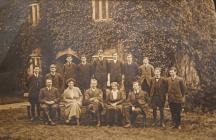Content can be downloaded for non-commercial purposes, such as for personal use or in educational resources.
For commercial purposes please contact the copyright holder directly.
Read more about the The Creative Archive Licence.
Description
As the excavation of Trench III continued, archaeological features became visible. Directly below the turf and topsoil there where two immediate changes. At the top of the north bank there was a deposit of light brown clay which contained a large concentration of gravel similar to that found in Trench II which we believed to be the remains of a pathway (Austin & Dollery 2011). Within the fill of the large feature there was also a clear change from a clay to a fine silt which in the upper part of the context had some charcoal and scattered finds, all of which probably dated to the 19th century and where therefore due to these finds being located close to the topsoil where probably residual (Barker 1982). There was a theory before the excavation of Trench III began that perhaps much of the demolition material from the old Middleton Hall may have been used to fill in the water feature to totally eradicate any trace of habitation within this area of the parkland, and from what had been discovered, this certainly seem logical considering the lengths Sir William Paxton had gone to systematically remove any traces of the Hall. However as you can see from this picture, the fill of the water feature did not contain any debris or charcoal which would be expected if the feature had indeed been filled in from the detritus of the hall (Austin & Dollery 2011).
This photograph was taken looking west. It shows the light brown clay mixed with gravel which are the remains of a possible track way to the left of the photograph. To the right you can see an area of darker brown soil, this is the fill of the water feature. Also if you glance to the top right of the photograph which relates to the west bank, you will notice that the dark brown soil narrows. This is a possible archaeological feature that has to date been theorised to be a sluice, possibly where a trench or cut was excavated into the bank to let out water from the water feature, possibly dating to the Paxton era of the estate (Austin & Dollery 2001).
Austin, D. & Dollery, J. The Excavation. In Austin, D [Ed] 2011 Paradise Lost In Search of a Garden before the Garden: Middleton Hall. Report of project conducted in 2011. Heritage Lottery Fund
Barker, P. 1982 Techniques of Archaeological Excavation. London. Batsford






Do you have information to add to this item? Please leave a comment
Comments (0)
You must be logged in to leave a comment